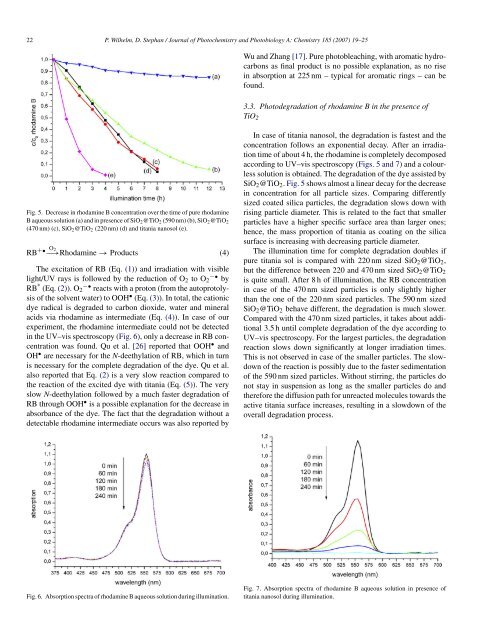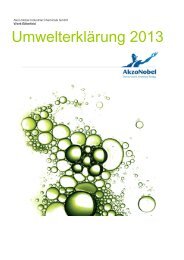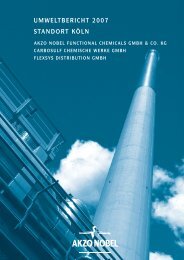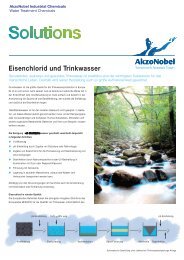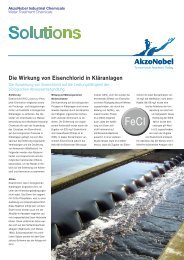Photodegradation of rhodamine B in aqueous solution ... - AkzoNobel
Photodegradation of rhodamine B in aqueous solution ... - AkzoNobel
Photodegradation of rhodamine B in aqueous solution ... - AkzoNobel
You also want an ePaper? Increase the reach of your titles
YUMPU automatically turns print PDFs into web optimized ePapers that Google loves.
22 P. Wilhelm, D. Stephan / Journal <strong>of</strong> Photochemistry and Photobiology A: Chemistry 185 (2007) 19–25<br />
Fig. 5. Decrease <strong>in</strong> <strong>rhodam<strong>in</strong>e</strong> B concentration over the time <strong>of</strong> pure <strong>rhodam<strong>in</strong>e</strong><br />
B <strong>aqueous</strong> <strong>solution</strong> (a) and <strong>in</strong> presence <strong>of</strong> SiO2@TiO2 (590 nm) (b), SiO2@TiO2<br />
(470 nm) (c), SiO2@TiO2 (220 nm) (d) and titania nanosol (e).<br />
+• O2<br />
RB −→Rhodam<strong>in</strong>e → Products (4)<br />
The excitation <strong>of</strong> RB (Eq. (1)) and irradiation with visible<br />
light/UV rays is followed by the reduction <strong>of</strong> O2 to O2 −• by<br />
RB * (Eq. (2)). O2 −• reacts with a proton (from the autoprotolysis<br />
<strong>of</strong> the solvent water) to OOH • (Eq. (3)). In total, the cationic<br />
dye radical is degraded to carbon dioxide, water and m<strong>in</strong>eral<br />
acids via <strong>rhodam<strong>in</strong>e</strong> as <strong>in</strong>termediate (Eq. (4)). In case <strong>of</strong> our<br />
experiment, the <strong>rhodam<strong>in</strong>e</strong> <strong>in</strong>termediate could not be detected<br />
<strong>in</strong> the UV–vis spectroscopy (Fig. 6), only a decrease <strong>in</strong> RB concentration<br />
was found. Qu et al. [26] reported that OOH • and<br />
OH • are necessary for the N-deethylation <strong>of</strong> RB, which <strong>in</strong> turn<br />
is necessary for the complete degradation <strong>of</strong> the dye. Qu et al.<br />
also reported that Eq. (2) is a very slow reaction compared to<br />
the reaction <strong>of</strong> the excited dye with titania (Eq. (5)). The very<br />
slow N-deethylation followed by a much faster degradation <strong>of</strong><br />
RB through OOH • is a possible explanation for the decrease <strong>in</strong><br />
absorbance <strong>of</strong> the dye. The fact that the degradation without a<br />
detectable <strong>rhodam<strong>in</strong>e</strong> <strong>in</strong>termediate occurs was also reported by<br />
Fig. 6. Absorption spectra <strong>of</strong> <strong>rhodam<strong>in</strong>e</strong> B <strong>aqueous</strong> <strong>solution</strong> dur<strong>in</strong>g illum<strong>in</strong>ation.<br />
Wu and Zhang [17]. Pure photobleach<strong>in</strong>g, with aromatic hydrocarbons<br />
as f<strong>in</strong>al product is no possible explanation, as no rise<br />
<strong>in</strong> absorption at 225 nm – typical for aromatic r<strong>in</strong>gs – can be<br />
found.<br />
3.3. <strong>Photodegradation</strong> <strong>of</strong> <strong>rhodam<strong>in</strong>e</strong> B <strong>in</strong> the presence <strong>of</strong><br />
TiO2<br />
In case <strong>of</strong> titania nanosol, the degradation is fastest and the<br />
concentration follows an exponential decay. After an irradiation<br />
time <strong>of</strong> about 4 h, the <strong>rhodam<strong>in</strong>e</strong> is completely decomposed<br />
accord<strong>in</strong>g to UV–vis spectroscopy (Figs. 5 and 7) and a colourless<br />
<strong>solution</strong> is obta<strong>in</strong>ed. The degradation <strong>of</strong> the dye assisted by<br />
SiO2@TiO2. Fig. 5 shows almost a l<strong>in</strong>ear decay for the decrease<br />
<strong>in</strong> concentration for all particle sizes. Compar<strong>in</strong>g differently<br />
sized coated silica particles, the degradation slows down with<br />
ris<strong>in</strong>g particle diameter. This is related to the fact that smaller<br />
particles have a higher specific surface area than larger ones;<br />
hence, the mass proportion <strong>of</strong> titania as coat<strong>in</strong>g on the silica<br />
surface is <strong>in</strong>creas<strong>in</strong>g with decreas<strong>in</strong>g particle diameter.<br />
The illum<strong>in</strong>ation time for complete degradation doubles if<br />
pure titania sol is compared with 220 nm sized SiO2@TiO2,<br />
but the difference between 220 and 470 nm sized SiO2@TiO2<br />
is quite small. After 8 h <strong>of</strong> illum<strong>in</strong>ation, the RB concentration<br />
<strong>in</strong> case <strong>of</strong> the 470 nm sized particles is only slightly higher<br />
than the one <strong>of</strong> the 220 nm sized particles. The 590 nm sized<br />
SiO2@TiO2 behave different, the degradation is much slower.<br />
Compared with the 470 nm sized particles, it takes about additional<br />
3.5 h until complete degradation <strong>of</strong> the dye accord<strong>in</strong>g to<br />
UV–vis spectroscopy. For the largest particles, the degradation<br />
reaction slows down significantly at longer irradiation times.<br />
This is not observed <strong>in</strong> case <strong>of</strong> the smaller particles. The slowdown<br />
<strong>of</strong> the reaction is possibly due to the faster sedimentation<br />
<strong>of</strong> the 590 nm sized particles. Without stirr<strong>in</strong>g, the particles do<br />
not stay <strong>in</strong> suspension as long as the smaller particles do and<br />
therefore the diffusion path for unreacted molecules towards the<br />
active titania surface <strong>in</strong>creases, result<strong>in</strong>g <strong>in</strong> a slowdown <strong>of</strong> the<br />
overall degradation process.<br />
Fig. 7. Absorption spectra <strong>of</strong> <strong>rhodam<strong>in</strong>e</strong> B <strong>aqueous</strong> <strong>solution</strong> <strong>in</strong> presence <strong>of</strong><br />
titania nanosol dur<strong>in</strong>g illum<strong>in</strong>ation.


